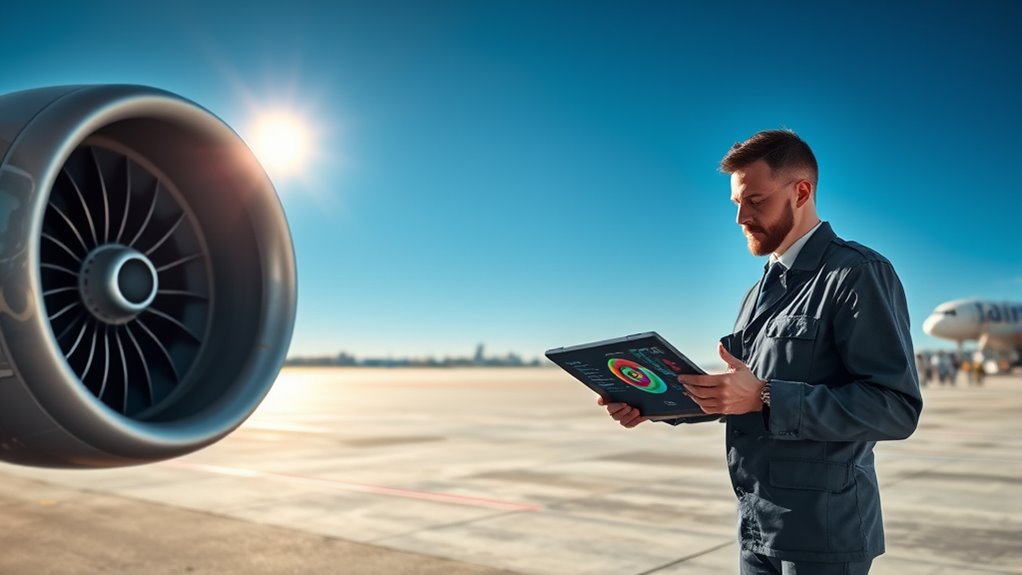Predictive maintenance uses sensor technology and AI analytics to track aircraft systems in real time, helping you spot issues before they cause delays. By analyzing data from engines, hydraulics, and avionics, you can schedule repairs during planned downtime and prevent unexpected failures. This approach reduces ground time, increases aircraft availability, and keeps flights on schedule. If you want to explore how this technology can boost operational efficiency further, there’s more to uncover below.
Key Takeaways
- Sensor technology enables real-time monitoring of aircraft systems, detecting wear and faults early to prevent delays.
- AI-driven data analysis optimizes maintenance scheduling, reducing unscheduled repairs and aircraft grounding time.
- Predictive maintenance prioritizes critical issues, allowing proactive repairs that minimize flight cancellations.
- Early fault detection enhances safety, ensuring timely interventions and smoother flight operations.
- Implementing AI-powered predictive maintenance improves fleet reliability, operational efficiency, and passenger satisfaction.

Predictive maintenance is transforming how airlines keep their airplanes safe and operational by predicting potential failures before they happen. This approach relies heavily on advanced aircraft sensor technology, which continuously monitors various systems and components in real time. These sensors gather critical data on engine performance, hydraulic systems, avionics, and more, allowing you to identify subtle signs of wear or malfunction that might otherwise go unnoticed until a failure occurs. By integrating this sensor data with sophisticated analytics, airline operators can develop precise maintenance scheduling strategies. Instead of adhering to rigid schedules, you can now plan repairs based on actual equipment condition, reducing unnecessary checks and avoiding unexpected breakdowns.
Predictive maintenance uses advanced sensors and analytics to optimize aircraft repairs and prevent failures before they happen.
With aircraft sensor technology, you gain the ability to detect issues early, often before they impact flight safety or cause delays. This proactive insight means you can schedule maintenance during planned downtimes, minimizing disruptions to flight schedules. As a result, aircraft spend less time grounded for routine checks and more time flying, which directly reduces delays and improves overall efficiency. These sensors also help you prioritize repairs, focusing on components that show signs of deterioration, rather than performing blanket maintenance on all parts regardless of their condition. This targeted approach saves costs and extends the lifespan of aircraft components.
Implementing effective maintenance scheduling strategies becomes easier with the wealth of real-time data provided by sensors. Instead of relying on fixed intervals, you can shift toward condition-based maintenance, where the timing of repairs aligns with actual equipment needs. This not only enhances safety but also optimizes resource allocation, ensuring that maintenance teams work on critical issues first. Additionally, predictive analytics allow you to anticipate potential failures across multiple systems, creating a detailed maintenance plan that reduces the likelihood of delays caused by unforeseen issues. Incorporating sensor data analysis into your maintenance routines further enhances predictive accuracy and operational efficiency.
You’ll also find that these strategies improve communication between maintenance crews and flight operations, as predictive insights provide clear, data-driven guidance. When scheduled well in advance, maintenance activities cause minimal impact on flight schedules, leading to smoother operations and happier passengers. Moreover, leveraging aircraft sensor technology and adaptive scheduling strategies positions your airline at the forefront of innovation, demonstrating a commitment to safety, efficiency, and customer satisfaction. Overall, embracing predictive maintenance with these tools means fewer delays, lower operational costs, and a more reliable fleet, ensuring your airline remains competitive in a fast-paced industry.
Frequently Asked Questions
How Does Predictive Maintenance Impact Airline Operational Costs?
Predictive maintenance substantially impacts your airline’s operational costs by enabling smarter maintenance scheduling, which reduces unexpected repairs and downtime. You experience cost savings because you can address issues before they escalate, avoiding expensive repairs and delays. By using data-driven insights, you optimize maintenance routines, ensuring your fleet stays operational longer and more efficiently. This proactive approach ultimately lowers your overall maintenance expenses and improves punctuality, benefiting your bottom line.
What Are the Privacy Concerns Related to AI Data Collection?
You should be aware that AI data collection raises data privacy concerns, as sensitive information could be improperly accessed or shared. Ethical considerations come into play, requiring transparency and consent from individuals whose data is collected. To protect privacy, companies must implement strict data security measures, comply with regulations, and prioritize ethical data handling practices, ensuring that personal information remains confidential and used responsibly.
How Accurate Are AI Predictions in Preventing Mechanical Failures?
AI predictions are quite accurate in preventing mechanical failures, provided sensor accuracy and data reliability are maintained. You can trust these systems to identify potential issues early, allowing you to perform timely maintenance. However, inaccuracies in sensors or unreliable data can reduce prediction effectiveness. Regular calibration and high-quality sensors guarantee the AI can analyze data precisely, boosting confidence in its ability to prevent failures and minimize delays.
Can Predictive Maintenance Fully Eliminate Flight Delays?
While predictive maintenance substantially improves aircraft scheduling, it can’t fully eliminate flight delays. Unexpected weather, air traffic, or operational issues still impact schedules. You might notice smoother departures and arrivals, enhancing passenger experience, but delays can still occur unpredictably. AI helps reduce, not erase, delays, so maintaining realistic expectations is key. Continuous advancements in predictive tech will narrow the gap, but complete elimination remains unlikely in the near future.
What Training Is Required for Maintenance Crews to Use AI Tools?
You need specialized maintenance training to effectively use AI tools, focusing on AI tool proficiency. This includes understanding how to interpret data outputs, troubleshoot issues, and integrate AI insights into your routine maintenance tasks. Hands-on practice, combined with classroom instruction, helps you become confident in using these tools. Continuous learning is essential, as AI technology evolves, ensuring you stay skilled and can maximize the benefits of predictive maintenance for safer, more efficient aircraft operations.
Conclusion
By embracing AI-driven predictive maintenance, you can minimize delays and keep flights running smoothly. This proactive approach helps catch issues early, saving time and money while enhancing passenger experience. Remember, a stitch in time saves nine—addressing problems before they escalate makes all the difference. So, harness the power of AI today, and watch your airline soar to new heights of efficiency and reliability.









